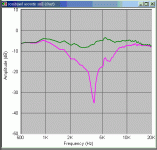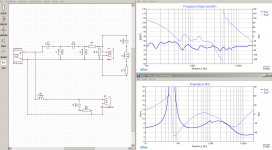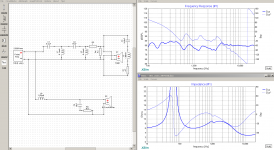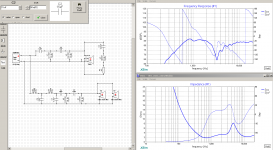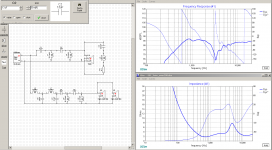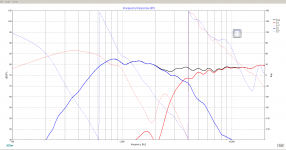How do we interpret a reverse null?
For example, suppose we have two different 2-way LR4 XO designs whose XO frequency points and responses are almost identical, but one has a 15dB reverse null and the other has a 30 dB null when the tweeter polarity is flipped. Then which one is better and why? I would appreciate some help.
For example, suppose we have two different 2-way LR4 XO designs whose XO frequency points and responses are almost identical, but one has a 15dB reverse null and the other has a 30 dB null when the tweeter polarity is flipped. Then which one is better and why? I would appreciate some help.
I would ignore the reverse connection happenings as they are irrelevant. Just look what's different between your correctly connected responses.
I imagine that the one with the greater null is actually aligned best when connected correctly, but that's a sweeping generalisation that may not mean that is actually the better design.
I imagine that the one with the greater null is actually aligned best when connected correctly, but that's a sweeping generalisation that may not mean that is actually the better design.
Yes, the amount of reverse null greatly depends on mic alignment.
But once you've got patient to get the drivers physically aligned, reverse null tells you a lot about your crossover performance.
No just the amount of null, center frequency and symmetry were also important. 1 or 2dB of response irregularity in correct polarity could easily be mix up by baffle deflection or cone resonance.
But once you've got patient to get the drivers physically aligned, reverse null tells you a lot about your crossover performance.
No just the amount of null, center frequency and symmetry were also important. 1 or 2dB of response irregularity in correct polarity could easily be mix up by baffle deflection or cone resonance.
Attachments
Thank you for your replies!
Actually, I'm trying to build 2-way bookshelf speakers with Dayton RS180 and Seas 27TBFC/G. I'm currently in a simulation stage and came up with two different XO designs. In simulations, two XOs' performance is virtually identical with each other w.r.t frequency response. But the modeled reverse null of one is 15dB down and the other, 30dB down. That's why I asked the question.
Actually, I'll start a thread for this project. So, your comments will be more than welcome!
Actually, I'm trying to build 2-way bookshelf speakers with Dayton RS180 and Seas 27TBFC/G. I'm currently in a simulation stage and came up with two different XO designs. In simulations, two XOs' performance is virtually identical with each other w.r.t frequency response. But the modeled reverse null of one is 15dB down and the other, 30dB down. That's why I asked the question.
Actually, I'll start a thread for this project. So, your comments will be more than welcome!
banana said:
But once you've got patient to get the drivers physically aligned,
reverse null tells you a lot about your crossover performance.
Hi,
It tells you a lot about meaningless "textbook" performance,
nothing else, precisely because of what you are saying.
note : talking about the maximum reverse null point.
Jay_WJ said:
Actually, I'm trying to build 2-way bookshelf speakers with Dayton
RS180 and Seas 27TBFC/G. I'm currently in a simulation stage and
came up with two different XO designs. In simulations, two XOs'
performance is virtually identical with each other w.r.t frequency
response. But the modeled reverse null of one is 15dB down and
the other, 30dB down. That's why I asked the question.
Hi,
If you trust such figures from purely simulating,
you know something I do not.
FWIW to get a very deep null the outputs of both drivers must
match exactly AND the phase be exactly 180 degrees at the
same frequency, and be measured at an equidistant point.
You usually have far bigger fish to fry ........
Are you planning on a flat or slanted baffle? If on a flat baffle, don't forget to enter an acoustic offset to align the drivers time wise, otherwise you will simulate phase alignment, but in reality will not be aligned due to acoustic offset. The simple math required for this can be found (I think) on the rjbaudio.com site.
Cheers,
David.
Cheers,
David.
Reverse null i feel is not soo important as the distortion at the crossover point of the individual driver is important. I always felt that just doing a simulation with the xover points will lead good mathematical xover point but listen to the single driver at that xover point and then decide is that ok for that driver and then do it again for the tweeter and see if the same xover point suits to it or no.
I felt irrespective of the reverse null the xover is xover it does the rolloff. Some times with you measure FRD data and the impedance then you endup tweaking slight offsets of the individual xover ponits to get nice gelling of the rolloffs.
But if someone corrects me that considering reverse null is right thing then please reply for the comment.
I felt irrespective of the reverse null the xover is xover it does the rolloff. Some times with you measure FRD data and the impedance then you endup tweaking slight offsets of the individual xover ponits to get nice gelling of the rolloffs.
But if someone corrects me that considering reverse null is right thing then please reply for the comment.
Three characteristics to look for:
1. Depth of null.
2. Width (VERY important!)
3. Symmetrical.
Essentially you want the phase angles to "dance" together as long as possible. This is why having it be deep AND wide is important. Depth can change due to resolution of measurements, so be careful, make sure to note whether you are using 1/3rd octave or 1/12th, etc. and be consistent.
The more they "dance" the better and smoother off axis will be.
Best,
E
1. Depth of null.
2. Width (VERY important!)
3. Symmetrical.
Essentially you want the phase angles to "dance" together as long as possible. This is why having it be deep AND wide is important. Depth can change due to resolution of measurements, so be careful, make sure to note whether you are using 1/3rd octave or 1/12th, etc. and be consistent.
The more they "dance" the better and smoother off axis will be.
Best,
E
This indicates poor phase matching. Here's a project to examine, pay attention to the phase plots of the individual drivers through the crossover region:
http://www.diyaudio.com/forums/multi-way/291438-lm-1-diy-speaker-available.html
http://www.diyaudio.com/forums/multi-way/291438-lm-1-diy-speaker-available.html
Last edited:
Rhythm, both are MUCH better, and in terms of phase matching, about the same. I would also look at / post the individual FR and phase plots (turn off the combined phase) in the FR diagram to help you decide. 
You may also want to try a Zobel on your mid, it may help things, and sometimes you can tweak the Zobel to help push the phase around.
You may also want to try a Zobel on your mid, it may help things, and sometimes you can tweak the Zobel to help push the phase around.
Deep null checking is valid for xovers from the LR family because drivers are in/out of phase for this family.
But not all xovers work with drivers in/out of phase. Some, like but3 for example, work with phase in quadrature which cannot be simply checked changing polarities and no null will show with this test.
But not all xovers work with drivers in/out of phase. Some, like but3 for example, work with phase in quadrature which cannot be simply checked changing polarities and no null will show with this test.
I do pay attention to the reverse null and try to get them as deep as possible, however, I concentrate 99% of my efforts on getting phase response as smooth as possible. It's when the phase is smooth that the sound opens up allowing more insight into the studio/venue etc. Poor phase control can make the sound vague and lacking depth.
I do pay attention to the reverse null and try to get them as deep as possible, however, I concentrate 99% of my efforts on getting phase response as smooth as possible. It's when the phase is smooth that the sound opens up allowing more insight into the studio/venue etc. Poor phase control can make the sound vague and lacking depth.
Amen, you nailed it!


- Status
- This old topic is closed. If you want to reopen this topic, contact a moderator using the "Report Post" button.
- Home
- Loudspeakers
- Multi-Way
- How to interpret reverse null?
